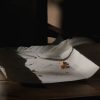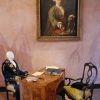The life of Carlo Goldoni progressed from Venice – where he was born in 1707, at Ca’ Centanni – to Paris, where he died in 1793.
A child endowed with uncommon wits, he expressed his passion for the theatre very early, so that we find him very soon playing intently with toy puppet theatres and, as a boy just turned eight, composing his first theatrical plot.
His family affairs led him to travel frequently around Italy. Following various mishaps with tutors and schools, he finally achieved his degree in Law in Padua, in 1731. He was to be assistant-clerk and lawyer, then a consul of Genoa in Venice. None of these professions appealed to him, his thoughts and his time were always bent towards the satisfaction of his yearning for the theatre. He avidly read Italian and foreign playwrights, composing pieces in various genres (librettos for musical operas, tragicomedies, dramas, tragedies, satires and poetry).
Carlo Goldoni entered into direct contact with the theatre world, knowing impresarios, authors, actors and lovers, handmaids, masks, organisers. From 1734 to 1743 he was at the Grimanis’ service at the Theatre of San Samuele. In 1747 he met the theatre impresario Gerolamo Medebach, signing a contract for the Theatre at Sant’Angelo. His ‘reformation’ activity on Italian theatre thus began at this point; his comedies would no longer be tangled mannerisms but true and ‘modern’ theatre texts, entirely committed to paper, with the various roles defined and assigned, line after line. No more ribaldry and weird plots, no more repertoire cues, very few or no masks at all: enlightened and bourgeois, modern theatre was born at last.
In 1750 Goldoni engaged in a sort of reckless challenge, composing 16 new plays in a single season. Albeit at the cost of a severe depression, Goldoni managed his task and among the new plays were also some masterpieces like La bottega del caffè (The Coffee Shop), La famiglia dell’antiquario (The Antiquarian’s Family), Il Bugiardo (The Liar). Over the following decade fundamental plays such as Il Campiello (The Little Square), La locandiera (The Mistress of the Inn), I Rusteghi (The Boors), Sior Todero Brontolon (Grumpy Mr. Todero), Le baruffe chiozzotte (The Chioggia Scuffles) followed.
In 1753 he passed over to the Theatre at San Luca, owned by Francesco Vendramin. By then, the topic in his plays was almost exclusively the world of the bourgeoisie, that new and increasingly characterised social class which increasingly supplanted the old traditional aristocracy due to its dynamism, business acumen, cultural feelings, gusto for the modern.
Summoned to Paris by the Théâtre-Italien, before leaving Venice Goldoni wrote Una delle ultime sere di carnevale (One of the Last Carnival Evenings), a sort of heart-rending farewell to his city. He reached Paris in November in 1762, where he was to experience a last season of activity and success, living between Paris and Versailles. In 1771 he dedicated himself to writing his Mémoires, an ironical and amusing autobiography, in a detached and cultured spirit.
He died in Paris on 6 February 1793 in total poverty.
–
Goldoni’s theatre output includes five tragedies, sixteen tragicomedies, one hundred and thirty-seven comedies, to which must be added, in the service of music, two sacred pieces, twenty entr’actes, thirteen dramas, forty-nine drammi giocosi, three farces and fifty-seven scenarios.
Downloads
Booklet to visit the Museum
![]() Casa di Carlo Goldoni. La Casa del suo Teatro
Casa di Carlo Goldoni. La Casa del suo Teatro
– Italiano (PDF 839 Kb) > – English (PDF 858 Kb) > – Français (PDF 840 Kb) >








